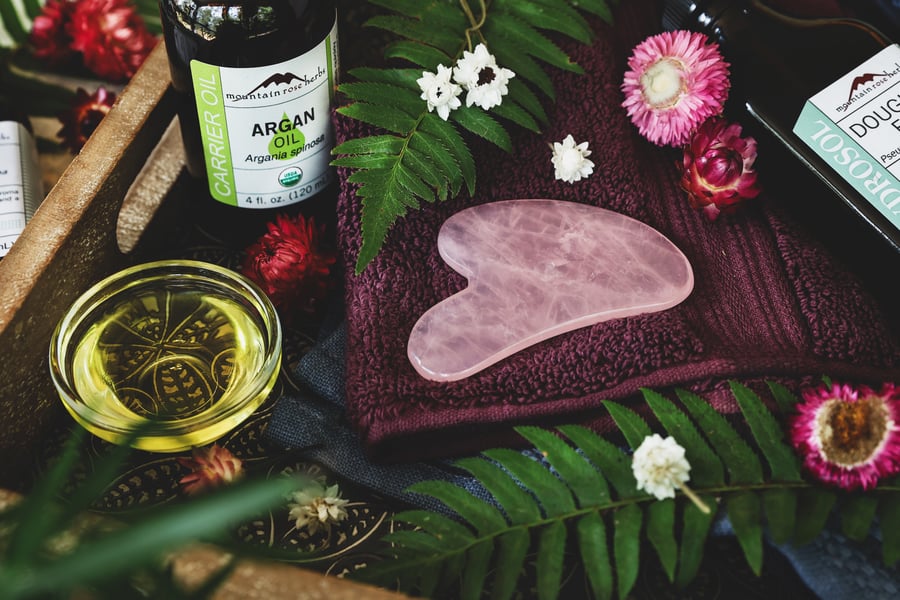“Guasha” (刮痧) translates as “scraping petechiae.” Gua (刮) is scraping, the act of pulling a guasha tool across the skin. Sha (痧) is petechiae: pinkness or redness on the skin that can arise from scraping, a result of increased blood circulation to the area. Guasha is one of the many tools in our East Asian medicine toolkit, which also includes acupuncture, herbs, massage, moxibustion, energy work, lifestyle medicine, and more.
Benefits of Guasha
By drawing a guasha tool, or guasha ban (刮痧板), across the skin with varying degrees of pressure, we can elicit different effects on the body. Guasha can be used for facilitating tissue repair in musculoskeletal injuries, breaking up scar tissue, lymphatic drainage, and more. Traditionally, guasha has also been used in the early stages of a cold for “releasing the exterior.” In this article, I will focus on gentle facial guasha.
I often recommend facial guasha as an evening ritual, particularly in clients experiencing chronic jaw tension that can lead to bruxism, or grinding teeth during sleep. Chronic jaw tension can also lead to headaches, especially temporal (side of head), or occipital (nape of neck) headaches. I also love recommending this facial guasha evening ritual for folks with dry skin and too many thoughts, as a way to simultaneously nourish the skin, cultivate an easy self-care ritual, and relax before bed.
What Is Needed for Guasha Facials
- Your preferred facial cleanser
- Guasha tool
- Organic hydrosol
- Organic oil or serums
How to Choose Guasha Tools
Guasha tools can be made of stone, bone, wood, or metal. Jade is said to balance the skin as a calm, grounding stone. Rose quartz purportedly soothes and nourishes self-love. Jade and rose quartz are both nice to place into the fridge, for cooling guasha for hot seasons. Obsidian is said to be a warming stone that can help clarify congestion and can be lovely wrapped in a hot towel for warming guasha for cold seasons.
You can also use the techniques of guasha with your hands as a simple massage tool, or a spoon with smooth edges, such as porcelain.
Different guasha tool shapes fit different body areas and match the hand of the tool holder. For facial guasha, I typically recommend stone or metal guasha tools in a “fish” shape (with a pointier tip on one side, and a lightly bifurcated “tail” on the other side), which matches various contours of most faces quite nicely.
Begin with a tool that makes you happy. There are many different guasha options in commerce these days; don’t get confused with snazzy advertising. If you like the color, shape, and texture of your guasha tool, then you are more likely to engage with this guasha practice. 
Best Hydrosols for Natural Facial Toner
A steam distillation of fresh aromatic leaves, fruits, flowers, and other plant materials yields an aromatic hydrosol and essential oil. Hydrosols are the hydrophilic, or water-loving, water-soluble constituents in plants. They have similar aromatic properties as essential oils, without the concentrated potential toxicity. Hydrosols are lovely spritzed onto the skin and body, and can also be spritzed around a space.
Here are some of my favorite hydrosols for facial guasha:
- Astringent: rose, rose geranium
- Skin mending: calendula, helichrysum, frankincense
- Calming/ soothing “hot” skin, antioxidant: chamomile, lavandin, tulsi
- Clarifying: neroli, sages, Douglas fir
Best Oils for Guasha
After spritzing hydrosol onto your face, lightly press the aromatic liquid goodness into your face. Then, apply your favorite organic non-comedogenic oil or facial serum. Drop a few drops of oil onto your hands, rub them together to emulsify, then lightly spread across your face. A little oil goes a long way.
My favorite is argan oil. Argan oil is light and easily absorbed, and makes for a delicious skin food with tocopherols, phenols, carotenes, squalene, and fatty acids.
Other oils you can experiment with include jojoba oil, rosehip seed oil, helichrysum essential oil, and vitamins E and C.
Learn to make your own serum here:
How to Do a Guasha Massage
- Cleanse your face.
- Spray hydrosol across your face and neck. Press and massage into your skin.
- Squeeze 2-3 drops of oil into your hands. Rub your hands together, then massage into your skin.
- Guasha! Starting from your neck and working up towards your forehead, gently guasha upwards and outwards three times across each section of your face, on each side. Work from your clavicle to neck, chin to jawline, lips to cheeks, under the eyes to the temples, above the eyes/ eyebrows to the temples, and forehead to the hairline. Apply featherlight pressure to your face; you don’t want to create any sha, or redness. Lightly massage acupressure points, such as at the corner of the jaw, on the side of your nose if congested, and at your temples.
How to Clean Your Guasha Tool
Guasha daily or weekly, depending on your needs and preferences. Wash your guasha tool with hot soapy water, then towel dry.
Stone guasha tools are delicate; store them in a soft pouch. Metal and bone guasha tools can handle more roughhousing, so are easy to travel with, and don’t need to be stored as carefully. Make sure that you thoroughly dry wood guasha tools, and occasionally season the wood. If using a spoon, then preferably you have a dedicated guasha spoon that lives in your toiletries cabinet, and not your kitchen. If using just your hands, then massage residual oil into your hands, deeply inhale the aromatics, and feel blessed by these ancestral traditions and healing plant ways!
Want to learn more from jiling lin?
Find Her at JilingLin.com
You may also enjoy:
- East Asian Herbal Liniment + Poultice Recipe
- How to Use TCM Herbs for Nourishing Soups
- Healthy Breakfast Recipes + 5 Superfood Powder Blends











